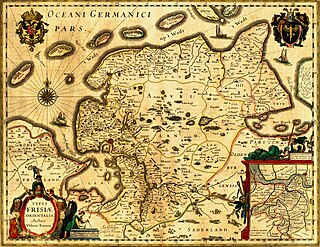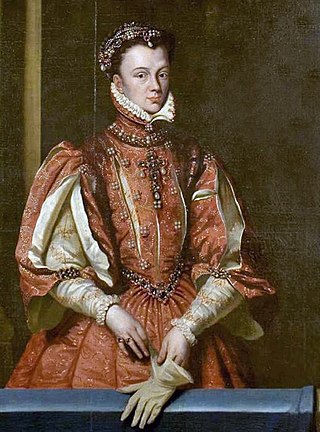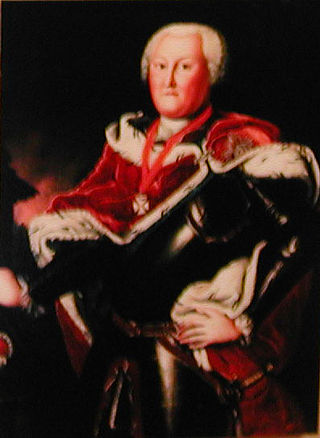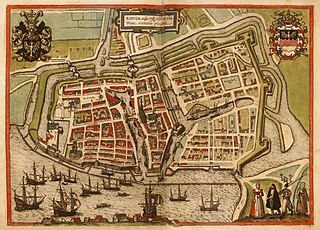Related Research Articles

Enno III of Ostfriesland or Enno III of East Frisia was a Count of Ostfriesland from 1599 to 1625 from the Cirksena family. He was the elder son of Count Edzard II of Ostfriesland and his wife Princess Katarina of Sweden, eldest daughter of King Gustav I of Sweden.

Edzard II was Count of East Frisia from 1561 to 1599. He was the son of Enno II of East Frisia and Anna of Oldenburg.

The County of East Frisia was a county in the region of East Frisia in the northwest of the present-day German state of Lower Saxony.

Ulrich I of East Frisia was the first count of East Frisia, from 1408 in Norden to 25 or 26 September 1466, in Emden. He was a son of the chieftain Enno Edzardisna of Norden and Greetsiel, and Gela of Manslagt.

Edzard I, also Edzard the Great was count of East Frisia from 1491 until his death in 1528.

Enno II of East Frisia was the son of Edzard I of East Frisia. In 1528 he became count of East Frisia. For most of his life he ruled together with Johan I of East Frisia, who remained Catholic, while Enno was Lutheran.

Anna of Oldenburg was a Countess consort of East Frisia as the spouse of Count Enno II of East Frisia. She was the Regent of East Frisia in 1542–1561 as the guardian for her minor sons, Johan II and Edzard II. Her reign lasted until 1561 and was generally supported by the Estates.

The House of Cirksena was the ruling family of East Frisia. They descended from a line of East Frisian chieftains from Greetsiel.

Theda Ukena was from 1466 to about 1480 regent of the County of East Frisia.

Count Johan II of East Frisia was a member of the House of Cirksena and from 1561 until his death in 1591 co-regent of the county of East Frisia. He ruled jointly with his brother Edzard II.

George Albert was a member of the family of the Cirksena and was the fourth Prince of East Frisia. He ruled from 1708 to 1734.

Charles Edzard was the last prince of East Frisia. He ruled from 12 June 1734 until his death.
Count Ferdinand Edzard of East Frisia was known as the "Count of Norden".
Enno Edzardisna was a chieftain of Norden, Greetsiel, Berum and Pilsum in East Frisia. He was the son of the chieftain Edzard II of Appingen-Greetsiel and his wife Doda tom Brok. Enno was a pioneer of the claim of the house Cirksena to the rule over all of East Frisia, which his son finally Ulrich I formally achieved when he was made an Imperial Count in 1464.
Johan I of East Frisia (1506–1572) was a member of the house of Cirksena and a non-reigning Count of East Frisia and later imperial governor of Limburg. His father, Edzard the Great, had introduced primogeniture in the county of East Frisia, so that his older brother Enno II of East Frisia inherited the county alone and he had to hold back. Despite his ambitions, he always acknowledged his brother's rights and did not dispute the inheritance.
John III of Rietberg was a member of the Cirksena family. He founded the Catholic side line of the Cirksena in the Westphalian County of Rietberg, the so-called house of East Frisia.

Sibet Attena was an East Frisian chieftain. He was a son of Sibet of Dornum and Frouwa of Manslagt, a daughter of Enno Cirksena.

The Emden Revolution of 18 March 1595 marked the beginning of the status of Emden as a quasi-autonomous city-state.
The Appeal War was a conflict between Prince George Albert of East Frisia and the Estates of East Frisia about the authority to raise taxes, so properly speaking, it should be classified as a civil war. It was named after Heinrich Bernhard von dem Appelle. Heinrich Bernard was one of the leaders of the rebellious faction, who were called the renitents. He owned the Groß Midlum manor in Krummhörn and was the administrator of the chamber of knights in the Estates of East Frisia.
References
- ↑ Ubbo Emmius: Friesische Geschichte, Frankfurt am Main, 1980-1982
- ↑ Eggerik Beninga: Historie van Oost-Frieslant, Emden, 1723